

Hack the Moon.
Z303C (Adzam) Dekatron - Counting Tube. Bi-directional double-pulse decimal counting/ selector tube.
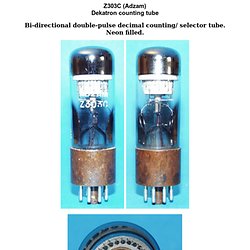
Neon filled. The following pictures show the tube spinning. Of course, only one of the cathodes is glowing, but the opening time of the camera leads to that different pictures: a middle opening time of the camera: a short opening time of the camera: a long opening time of the camera: by night, with long opening time of the camera: An animation of a spinning dekatron: Pinout & Outline: Downloads/Datasheets: Sie finden passende Datenblätter im Datenblattarchiv. You'll find the matching datasheets in the datasheet archive. Back to Dieter's Nixie Tube PageeMail to DieterDisclaimerImpressum. Before microprocessors - pagina 2. Prima dei microprocessori (2) - Vintage computer technologies (before micros - 2) Pensate che scrivere "prima dei microprocessori" non sia storicamente corretto per tutti gli oggetti raffigurati qui?
GEEK. Alan Turing Centenary. ACM. Manchester. S Barry Cooper.2012 Turing Machine Test. BBC on Turing Codebreaker. Microbes Mind Forum (M. The output signals, the only externally visible indication of the internal state (the light) are described by the table State q1... q2... q3...
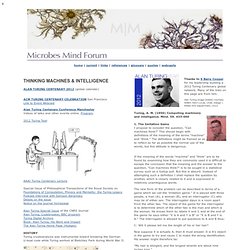
Output Oo... Oo... O1 This example is typical of discrete-state machines. It will seem that given the initial state of the machine and the input signals it is always possible to predict all future states, This is reminiscent of Laplace's view that from the complete state of the universe at one moment of time, as described by the positions and velocities of all particles, it should be possible to predict all future states. As we have mentioned, digital computers fall within the class of discrete-state machines. Given the table corresponding to a discrete-state machine it is possible to predict what it will do. This special property of digital computers, that they can mimic any discrete-state machine, is described by saying that they are universal machines.
We may now consider again the point raised at the end of §3. 6. Witness: It wouldn't scan. Computer Resurrection Issue 43. Computer The Bulletin of the Computer Conservation Society Contents Greetings!
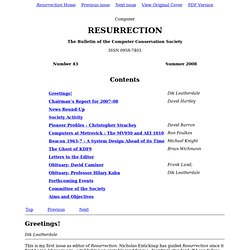
Dik Leatherdale. Turing, Father of the Modern Computer. Snapped for a passport photo TuringA smile for his centenary ©B.
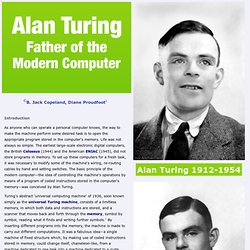
Jack Copeland, Diane Proudfoot Introduction. Regoli di Genaille - Lucas / Genaille - Lucas rules. University of Texas at Austin Computation Center Artifacts. Apple Industrial Designers Robert Brunner and Jerry Manock.
Post WAR II. MEDIA. Colossus: The Secrets of Bletchley Park's Codebreaking Computers. Colossus at wartime Bletchley Park.

Table of Contents Colossus and two operators from the Women’s Royal Naval Service, Dorothy Du Boisson (left) and Elsie Booker.2. MUSEUM&LIBRARY. Detail. A mobile phone from 1922? Not quite. 05. Calcolatori analogici. Antique Computers - Ed Thelen. From: L Roth To: IBM 604 Sent: Sunday, February 07, 2010 Subject: hello, 604 units Hello Ed, Very interseting site on the IBM 604.
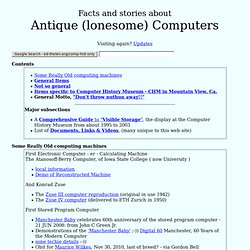
I graduated from an electronics school in Mpls in 1960. Our instruction back than on computers consisted of flip-flop circuits to learn basics. An interesting project was the Overbeck ring and an "electronic roulette wheel" using the 2-xxxx triggers - flip-flops. After I graduated from tech school I ended up in Seattle,WA. And a response from Robert Garner L Roth, Thanks for your informative note to Ed. Turns out that an older colleague of mine (Hans Coufal) at IBM Almaden Research (who's no longer with us), had reportedly collected much of a 604, apparently still in storage somewhere in L.A. . - Robert p.s. The evolution of computer languages (infographic) Programming languages, believe it or not, have existed for over 200 years, since the invention of the punch-card-programmable Jacquard loom.
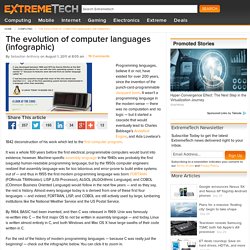
It wasn’t a programming language in the modern sense — there was no computation and no logic — but it started a cascade that would eventually lead to Charles Babbage’s Analytical Engine, and Ada Lovelace’s 1842 deconstruction of his work which led to the first computer program. It was a whole 100 years before the first electrical, programmable computers would burst into existence, however. Machine-specific assembly language in the 1940s was probably the first (vaguely) human-readable programming language, but by the 1950s computer engineers realized that assembly language was far too laborious and error-prone to build entire systems out of — and thus in 1955 the first modern programming language was born: FORTRAN (FORmula TRANslator).
By 1964, BASIC had been invented, and then C was released in 1969. Infographic via Rackspace.